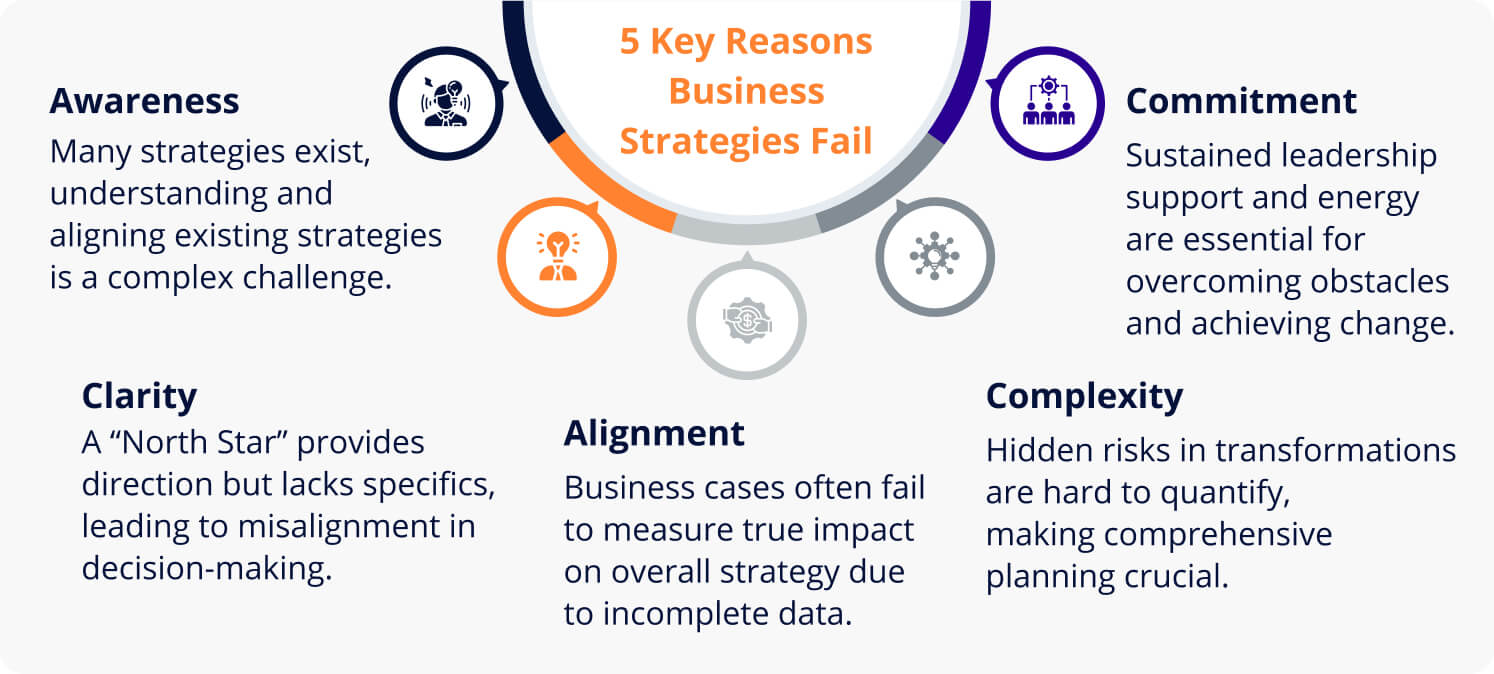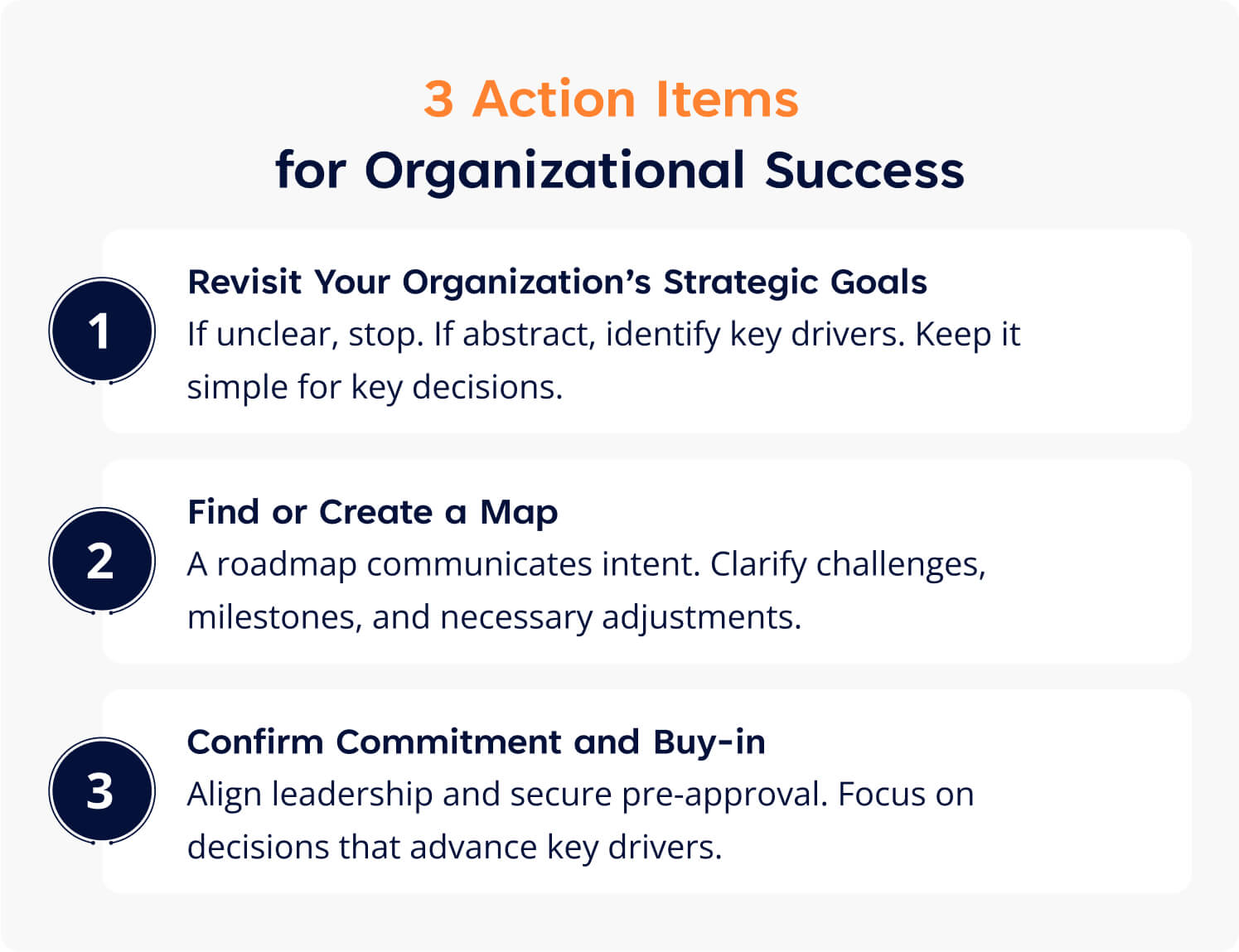Strategy in Motion | A Roadmap to Strategic Success

Your “North Star” strategy isn’t enough!
In conversations with companies, it is not uncommon to hear various iterations of the following statements:
“We have our strategy set; what we need is a solid business case to proceed."
“I am confident that we have the right plan, we just need help with architecting the solutions.”
“Our key challenge is ensuring that everyone is on board with the changes that we need to make.”
These statements all point to gaps in closing the loop between a company's strategy and how that strategy is understood, internalized, and actuated to drive the intended business outcomes.
The conventional wisdom on strategy has shifted over time to focus on fewer, more targets. This shift was an effort to ensure that the entire organization moves in the same direction, towards the same “North Star”. This is still excellent advice and a highly recommended initial step in goal setting. So why is it not working as anticipated?
Why isn’t a clearly communicated North Star delivering results? There are five key reasons why we have not yet closed the loop.

The 5 Key Reasons Business Strategies Fail
1. Awareness | What Exactly is the Strategy?
There are many forms of strategy circulating in today’s organizations. There are corporate strategies, business strategies, functional strategies,
operational strategies, and multiple enablement strategies. The average director or team leader is trying to maintain alignment with a myriad of strategies while delivering on their specific goals and objectives.
In the technical ranks, this usually results in increasing technical debt. This technical debt is directly attributable to making tradeoffs between addressing immediate issues and strategic-minded decisions to move toward a better future state solution.
Customer service leads must prioritize decisions based on customer-specific needs and the anticipated value of that customer, while generally advancing the strategy of the organization. Operations leads are making tradeoffs to ensure schedules are met and production goals attained, with a general understanding of the ultimate impact on the strategic goals the business is pursuing.
It is neither feasible nor practical for each of these resources to have a complete understanding of the various strategies to accomplish their activities. Yet, these are the expectations that leadership has placed upon them.
2. Clarity | A North Star is Far Away and Hard to See Clearly
The goal of an organizational North Star is important and highly recommended, but too often the organization needs far more to guide the way, especially when addressing major transformational changes.
If the organization is trying something large, say a pivot to a seamless digital-first customer experience, then significant time and effort will be needed across most of the organization, each contributing their piece of the puzzle.
Aligning these various groups around a common North Star goal or vision of the future provides some guardrails against distracting forces. Individual decisions are still happening within those wide guardrails that can cause significant unit-to-unit misalignments that need to be addressed. The North Star strategy usually does not translate to a line manager’s activity decisions, nor does a North Star provide clues as to ways to mature or optimize current capabilities.

3. Allignment | Business Cases Rarely Measure True Impact on Overall Strategy
It is very common for leadership to require justification for the allocation or re-allocation of resources. Companies are faced with multiple competing priorities, and it is often difficult to determine which opportunities will make the greatest impact.
The traditional approach is to rely on business cases for this justification. Allocation of resources based on the strength of the business case is a great principle and would be optimal if the business cases in question were of sufficient quality and detail to provide accurate guidance. Unfortunately, business cases are often well-intentioned but do not provide realistic assessment of the current situation, reliable estimation of long-term value generated, total cost to be incurred, or true holistic impact to the company’ stated goals.
This is not the fault of the business case creators, but more often the result of an incomplete or too high-level business strategy that they are trying to interpret. Say the head of manufacturing proposes transforming core processes and systems to increase production by 10%, reduce defects by 5%,and save $60 million over two years. At the same time, the head of digital presents a business case with identical cost, return, and risk levels over the same timeframe. Given these scenarios, which business case should be prioritized?
Even if all attributes are carefully compared and considered, it is still challenging to make the ultimate decision.
4. Complexity | Strategy Alone Falls Short in Guiding Change
There are far more hidden dangers and impacts of transformations than stakeholders can often contemplate. Like the metaphorical iceberg, the largest risks and impacts of most transformation programs exist below the perceived horizon and are not visible at first glance.
The need for effective comprehensive planning and change management programs has never been greater. Today’s interconnected and mutually dependent systems, processes, workflows,
and teams all conspire to cascade and escalate small areas of friction into sluggish business operations. Recognizing that risks are ever present and rarely quantifiable is crucial, and translating this awareness into mitigative activities often proves harder than anticipated.
5. Commitment | Lack of Momentum to See the Change All the Way Through
The last key reason for a failure to deliver on strategy is the lack of sustained commitment to the transformation required. Most business transformations are hard and require a constant infusion of energy and a continual re-commitment of support through the toughest times.
In the space industry, it is not failure to launch that is the problem; it is failure to achieve enough momentum to reach escape velocity (without first blowing up). Obvious, vocal, and full-throated commitment by leadership, backed up by budgets, is often the difference between the success and failure of a transformation project.
Major, multi-year, multi-million-dollar Enterprise Resource Planning (ERP) transformation failures fill business school case studies. Organizations that had every intention of seeing the change all the way through to completion, had instead abandoned the project when either the costs or timelines started to balloon.

These five key reasons why our current strategies fail to yield business outcomes may not cover all the possible reasons but are the usual suspects in why so many companies struggle to complete strategic transformational changes as planned.
Navigating Your Strategic Course | Essential Actions for Organizational Success
But all is not lost. There are a few actions that organizations can take to right their Strategic Ship.
Action Item 1 | Revisit Your Organization's Strategic Goals
If your strategic goals are not clear and discernable enough to guide decision-making or prioritization, stop here—your journey will likely fail. If they are understandable but abstract, dig deeper to uncover the key drivers that propel your company’s mission forward. Keep these drivers clear and simple and use them to guide all key decisions.
Action Item 2 | Confirm Commitment and Buy-in for the Full Journey
Do not start your transformational journey without a roadmap. A roadmap, however incomplete or inaccurate, is still better than no map at all. A roadmap provides a clear form of intent communication to all those involved. Instead of telling everyone that our destination is west, offer a preview of what the first few miles will be like on that westward journey. The roadmap should provide clarity of what needs to be confronted and overcome, what milestones to watch for and, when those are accomplished, what adjustments are needed to proceed.
The roadmap should be built from core principles: strategic goals (drivers), an honest evaluation of current capabilities, future capability needs, and measures of alignment. The map needs to be understandable to all those who will reference it for guidance. While it does not need to be highly detailed, it should be organized into clear “swimlanes” of activities, each with its appropriate level of actionable items.
Action Item 3 | Find or Create a Roadmap
The best way to achieve long-term institutional commitment is to ensure two key components: aligned leadership and measurable outcomes. Aligning leadership alone is challenging enough, but the most effective strategy is to get pre-approval for decisions. As with major personal purchases like a house, it is recommended that you always arrange pre-approval. For transformation journeys, pre-approval involves aligning all key leadership with the drivers and then ensuring that all priorities and decisions focus on what moves the needle on those drivers.

How RCG Can Help
RCG’s Strategy and Roadmap process can quickly review your organization’s business strategies, identify and clarify key business and IT drivers, and uncover and prioritize opportunities. The process can also provide an actionable prioritized roadmap based on drivers, with clarity of responsibilities in swimlanes to orchestrate the changes needed to achieve the business outcome.

Works Cited
Download a PDF version of this ebook by filling out this form.

